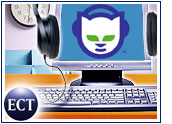
In its most direct challenge yet to the dominance of Apple’s iTunes Music Store, Napster on Tuesday launched what it says is the largest online MP3 download store, selling some six million tracks.
All of the songs offered for download by Napster are free of digital rights management (DRM) controls, meaning they can be played on virtually any device, including Apple’s iPod and iPhone.
The move is a seismic shift for Napster, which since being reborn as a legitimate company — after its initial incarnation as a piracy tool was brought to an end by legal challenges — has focused on selling music through a monthly subscription model.
Per-Track Offering
“Music fans have spoken” and have expressed the desire to have music in DRM-free MP3 format, said Napster CEO Chris Gorog.
“Virtually any portable device in the world can now be used to enjoy tracks purchased at Napster, which is an important breakthrough for our company,” he added. The company will offer per-track downloads alongside its subscription plans.
Napster shares moved higher by more than 5 percent in afternoon trading Tuesday to US$1.62. Despite a down market day, Apple shares were also modestly higher, rising a quarter of a percentage point to $184.05.
Battle Joined
Unlike others to enter the market — notably Amazon — Napster’s download store does not seek to underprice the iTunes Music Store, selling individual tracks for 99 cents and charging $9.95 for most albums. Like iTunes, the Napster store also enables users to download album cover art with their songs.
By launching DRM-free downloads, Napster opens up a significant market for itself in the form of the millions of existing iPod owners, JupiterResearch analyst Mark Mulligan told the E-Commerce Times.
Although Apple has moved to offer more music in DRM-free format, much of its music still comes with limitations on how many times music can be copied onto different computers or portable devices, he noted.
“By acting now, Napster can use the fact that the entire catalog is DRM-free as a differentiator,” Mulligan said. “But they’re walking a fine line themselves.”
That’s because their core subscription service still comes with DRM restrictions that are in some ways more limiting. For instance, if a user allows his subscription to lapse, music already downloaded will stop working. “The much bigger and bolder step for Napster would be to go DRM-free on subscription services,” Mulligan added, though such a move is fraught with business model complications.
Sign of Capitulation?
Napster’s subscription model has had significant traction, growing to about three-quarter-of-a-million subscribers, who get the right to consume all the music they want for a monthly fee and can stream songs to their PCs and download them to certain portable devices.
The MP3 shift could help jump-start growth and expose an entire new audience to Napster’s choices.
Apple is unlikely to be impacted in the short term by the Napster shift, given that it has not yet suffered from the Amazon launch, which also offers DRM-free music that works on iPods — with many tracks priced less, Forrester Research analyst James McQuivey told the E-Commerce Times.
Although Apple has become the dominant digital music purveyor, music labels are eager to see alternatives developed that can break Apple’s grip on the business, and the market remains in its early phase, with growth of more than 20 percent in the amount of digital music sold each year predicted for the next three years. By 2011, McQuivey said, half of all music sold will be digital downloads.
“This move gives Napster a foot in each of the two major business models around digital music,” he added. “Whether that will translate into a leadership position in the future remains to be seen.”





















































Social Media
See all Social Media